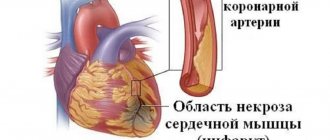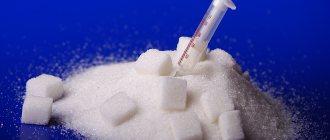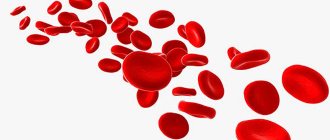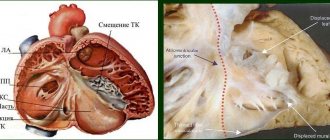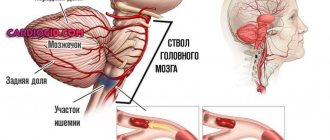What is collapse
In many diseases, a disruption may occur in the functioning of the autonomic nervous system, which is responsible for regulating vascular tone. In such situations, acute vascular insufficiency may develop.
During collapse, pressure drops as paresis of small vessels occurs. The volume of blood moving through them decreases sharply, and blood flow slows down. This leads to the fact that the brain ceases to receive the necessary amount of oxygen and nutrients. The same goes for the heart muscle.
In this condition, blood supply throughout the body is disrupted, which leads to metabolic disorders. Not only neuro-reflex disorders can lead to vascular insufficiency, but also toxic substances of a protein nature. This usually happens during infectious diseases, such as pneumonia, typhus, during a heart attack or severe blood loss.
Types of collapse
In medicine, collapse is classified according to the pathogenetic principle, but to a greater extent it is divided according to etiology, so we can say that collapse can be:
- Infectious-toxic - it is provoked by bacteria that cause infectious diseases.
- Toxic - develops due to general poisoning of the body. A toxic collapse can be triggered by human activities related to his professional affiliation, for example, when working with amino compounds and so on.
- Hypoxemic - can develop with increased atmospheric pressure, as well as with a lack of oxygen in the air.
- Pancreatic - occurs with injuries or contusions of the pancreas.
- Burn - severe thermal skin damage.
- Hyperthermic - provokes severe overheating of the body or sunstroke.
- Dehydration - occurs as a result of dehydration of the body.
- Hemorrhagic - can be observed with heavy bleeding. Currently, this condition is called deep shock.
- Cardiogenic - develops as a result of the progression of cardiac diseases.
- Plasmorrhagic - develops due to loss of plasma, which can be observed with a complicated form of diarrhea or with extensive burns in large quantities.
- Orthostatic - occurs when a rapid change in the position of the human body from a lying position to an upright position. This phenomenon can be observed in patients leading a sedentary lifestyle. But collapse can also occur when standing in an upright position for a long time, since in this case the venous blood flow increases and the blood flow to the heart decreases. This phenomenon can be observed in healthy adults, as well as in childhood and adolescence.
- Enterogenous - can develop in people with gastric resection after eating.
Types of collapse
Depending on the clinic and pathogenesis, collapse is divided into three types:
- Sympathotonic. This form of collapse is accompanied by increased tone of the sympathetic nervous system, which leads to spasm of the arteries throughout the body. Systolic pressure in such situations is normal or slightly elevated, and diastolic pressure is high. If such a collapse is observed, emergency care is required urgently so as not to develop more serious complications.
- Vagotonic collapse. In this state, the parasympathetic system comes into tone. The arteries, on the contrary, dilate, diastolic pressure decreases, and bradycardia is observed. The cause of this condition is fear, fainting, hypoglycemic coma.
- Paralytic. Most often it happens when the mechanisms that are responsible for regulating blood circulation are severely depleted. The vessels dilate, the pressure drops, and collapse occurs; emergency care comes down to normalizing, first of all, blood pressure.
Fainting, collapse: causes of development, diagnostic algorithm, emergency care.
In the pathogenesis of acute vascular insufficiency, the discrepancy between the capacity of the vessels and the amount of blood circulating in them is of decisive importance. Most often, loss of tone and vasodilation are observed in the abdominal organs. Stagnation of blood in them leads to the exclusion of a large amount of blood from the circulation. Due to a decrease in circulating blood volume, there is insufficient blood supply to the brain and other organs. On the other hand, a decrease in circulating blood volume is observed with blood loss, injury, shock, and dehydration. Acute vascular insufficiency can clinically manifest itself in the form of fainting, collapse and shock. The causes may be intoxication, hyperthermia, mental and physical trauma, surgery, especially with large blood loss, etc.
Fainting (syncope)
– short-term loss of consciousness developing as a result of acute cerebral ischemia. It is more often observed in girls during puberty, as well as in emotionally labile children, in whom blood redistribution easily occurs reflexively under the influence of various psychogenic influences.
Fainting clinic.
A sudden feeling of weakness, darkening of the eyes, tinnitus, dizziness, nausea, and sometimes vomiting appears. Then comes a short-term loss of consciousness. Blood pressure drops sharply - 50 - 60 mm Hg. Art. The pupils are constricted, the pulse is slow (40–50 per minute) or accelerated, heart sounds are muffled. Breathing is rare, shallow (sometimes deep). Severe pallor of the skin and mucous membranes. Profuse sweat. The duration of the attack is from several seconds to 1 minute.
First aid for fainting.
The patient must be placed in a horizontal position with the head end of the bed slightly lowered or with the lower limbs raised, ensure a sufficient flow of fresh air, unbutton (tear) tight clothing, sprinkle cold water on the chest and face, and warm the limbs (a heating pad). Inhalation of ammonia solution vapors is effective. This is usually enough to return consciousness and improve the condition. In more severe cases, inject intramuscularly 1 ml of a 10% solution of Caffeine or 2 ml of Cordiamin. Until consciousness is restored, blood circulation and breathing are normalized, the patient should be treated on the spot. Then, if necessary, place in a hospital to exclude any diseases of the internal organs and internal bleeding.
Collapse
– acute vascular insufficiency, resulting from a violation of the regulatory function of the vasomotor center, a sharp decrease in vascular tone (dilation and paresis), especially in the abdominal organs. This leads to accumulation of blood in the abdominal organs and cerebral ischemia.
Etiology of collapse.
The causes of collapse are severe acute infectious diseases, intoxication, blood loss, dehydration, damage to the adrenal glands, severe injuries, acute myocarditis. In this case, in contrast to fainting, not only functional, but also organic changes in the vessels are observed with an increase in the permeability of their walls and the release of plasma from the bloodstream. In the pathogenesis of collapse, the main significance is a decrease in the amount of circulating blood and cardiac output, and a decrease in blood pressure. Brain hypoxia develops, the function of the central nervous system, liver, kidneys and cardiovascular system is disrupted (secondary heart failure), azotemia and acidosis are noted.
Collapse Clinic.
The patient is initially restless, the skin is pale with a cyanotic tint (“marble”). Body temperature is reduced, tissue turgor is low, breathing is shallow and rapid. Then anxiety gives way to depression, the patient is lethargic, complains of weakness, chilliness, and thirst. Acrocyanosis, cold clammy sweat. Pulse – irregular, frequent, small filling. Subsequently, the patient is apathetic, motionless, facial features are sharpened, eyes are sunken; the pupils are dilated, weakly responsive to light, the muscles are relaxed. Blood pressure drops. The liver may be enlarged and tender to palpation. Frequent vomiting is often observed. Diuresis decreases. Consciousness is usually preserved. In all cases of collapse, a differential diagnosis should be made with heart failure due to different treatment tactics for these conditions. Depending on the pathogenesis and clinical manifestations, three types of collapse are currently distinguished: sympathotonic, vagotonic and paralytic.
Sympathotonic collapse
accompanied by a predominance of the tone of the sympathetic nervous system, which leads to spasm of the arterioles of internal organs, muscles, and skin. Blood accumulates in the heart and large vessels (centralization of blood circulation). Causes: blood loss, neurotoxicosis, acute dehydration. There is normal or increased systolic pressure with high diastolic and, therefore, sharply reduced pulse pressure.
Vagotonic collapse
develops against the background of predominance of the tone of the parasympathetic nervous system. There is an expansion of arterioles and arteriovenous anastomoses, in which blood accumulates during cerebral ischemia. Bradycardia, decreased diastolic and increased pulse pressure are observed. Causes: fainting, fear, hypoglycemic coma, anaphylactic shock, severe infections with damage to the adrenal glands.
Paralytic collapse
develops when the mechanisms regulating blood circulation are depleted. As a result, passive dilatation of blood vessels occurs, where blood is deposited, and cerebral ischemia. Causes: dehydration, neurotoxicosis, diabetic coma, severe intoxication, severe damage to the adrenal glands. Blood pressure (maximum and minimum) is sharply reduced.
Emergency care for collapse
carried out energetically: the prognosis depends on this. Since it is not always possible to determine the form of collapse clinically, treatment should be carried out with constant monitoring of blood pressure (maximum, minimum and pulse), as well as central venous pressure and diuresis (indwelling catheter in the bladder). First of all, it is necessary to restore the volume of circulating blood by blood transfusion (in case of blood loss), intravenous administration of blood plasma or plasma substitutes - rheopolyglucin, polyglucin, gelatinol under the control of hemoglobin content, electrolytes, hematocrit and acid-base status. The therapy carried out is at the same time detoxification. Measures are taken to normalize the tone of peripheral vessels. In case of sympathotonic collapse, drugs that relieve spasms are prescribed - 0.2 - 0.5 ml of a 2.5% solution of aminazine or pipolfen intramuscularly 3 - 4 times a day; novocaine 0.5 - 2 ml of 0.5% solution intravenously. Cordiamine, corazol, caffeine are contraindicated (increase vascular tone!).
In case of vagotonic and paralytic collapse, in parallel with infusion therapy, the administration of vasopressors is indicated - 5% ephedrine solution; 0.1% norepinephrine solution; 0.1 ml of 1% mesatone solution (repeat); cordiamine intramuscularly every 3–5 hours; 0.1 – 0.15 ml of 0.1% strychnine solution subcutaneously.
Corticosteroids (hydrocortisone, prednisolone) are prescribed. Treatment of the underlying disease (infection, intoxication) is mandatory. If secondary heart failure develops against the background of vascular insufficiency, strophanthin (0.2 - 0.4 ml of 0.05% solution) or corglycone is administered intravenously.
Source: studfile.net
Causes of collapse
Many reasons can cause a condition such as collapse:
- Severe blood loss after injuries, internal bleeding.
- Many infectious diseases, for example, hepatitis, scarlet fever, pneumonia.
- Girls are going through puberty.
- In the case when a patient, who has been lying down for a long time, tries to get up abruptly.
- Dehydration.
- Electric shock.
- Heatstroke.
- Exposure to ionizing radiation, especially in high doses.
- Poisoning with food or certain medications.
If collapse occurs as a result of the above reasons, emergency care will depend on them. In each case the steps will be different.
Causes
A sharp and pronounced decrease in the tone of the smooth muscle structures of the walls of arterial vessels is a polyetiological pathological condition, the development of which can be caused by several causes. The most common of these in children are:
- A significant increase (hyperglycemia) or decrease (hypoglycemia) in blood sugar levels.
- Insufficiency of the functional activity of the adrenal glands, which produce hormones that increase the tone of the smooth muscles of the arterial walls (glucocorticosteroids, adrenaline, norepinephrine).
- Poisoning of the body associated with exogenous (from outside) intake of various toxins.
- Severe course of infectious pathology with severe intoxication of the child’s body.
- Somatic pathology with damage to internal organs, heart, endocrine glands in the stage of decompensation.
Girls during puberty may develop vascular collapse, which can be triggered by exposure to psycho-emotional stress factors.
Signs of collapse
As a rule, recognizing collapse is not difficult. Its manifestations are usually clear and bright, so it is almost impossible to confuse it with other diseases. The main symptoms of collapse include the following:
- A sharp deterioration in a person's condition.
- Severe and sudden headache.
- Noise in ears.
- It gets dark in my eyes.
- Weakness in the body.
- Unpleasant sensations appear in the heart.
- A sharp decrease in pressure.
- The skin turns pale and cold sweat appears.
- A bluish tint appears in the nails, skin on the hands and feet.
- Facial features become sharper.
- Breathing becomes frequent and shallow.
- Body temperature decreases.
- The pulse is thread-like and difficult to palpate.
- Loss of consciousness often occurs.
Providing emergency assistance in case of collapse should be carried out immediately in order to bring the person out of this state as quickly as possible.
Collapse and shock
The difference between collapse and shock should be known in order to provide proper assistance. Their etiology differs, although they are both manifestations of the body’s general reaction to a strong damaging factor (poisoning, injury, death of a large area of the heart muscle, very severe pain, significant blood loss.
Shock begins to develop with a phase of excitement, which is replaced by a sharp depression of consciousness. In case of shock, there is a maximum decrease in blood pressure, which causes the cessation of excretory function of the kidneys. Without medical care for shock, almost 100% of deaths occur.
Symptoms of collapse in children
The child’s body is much more sensitive to any malfunction in its functioning, so the onset of collapse can be accurately recorded. The symptoms are usually the following:
- The child suddenly becomes ill.
- He is lethargic, he is not interested in the world around him.
- The skin becomes pale and covered in cold sweat.
- Cyanosis of the lips is observed.
- A thread-like pulse is barely palpable.
- Usually tachycardia, but bradycardia may also occur.
- Blood pressure drops sharply.
- Babies may experience convulsions due to hypoxia.
In such situations, emergency assistance for collapse in children is urgently required.
Medical assistance
Oral administration of drugs in a state of collapse does not make sense. Only infusion into a vein can help; subcutaneous or muscular administration of drugs will be ineffective, since tissue circulation is impaired and absorption of drugs will be insufficient.
Medical emergency care consists of administering drugs that increase the volume of circulating blood, as well as drugs that increase blood pressure. Polyglucin and salt solutions are often used, for example, isotonic sodium chloride solution. However, with the latter drug it is necessary to observe the exact dosage, since an excess of this drug can cause pulmonary edema.
If collapse occurs as a result of acute blood loss, then a blood transfusion is performed or fluids are administered to the patient, which are designed to provide blood replacement.
In case of collapse of cardiogenic etiology, such measures are not carried out due to possible pulmonary edema. In this case, preference is given to pressor amines. The same measures are taken for anaphylactic collapse.
Norepinephrine influences blood vessels and cardiac activity. Dopamine has a vascular and selective effect. It not only constricts blood vessels, but also helps to dilate renal vessels and vessels leading to other organs.
Due to the fact that collapse can be triggered by various factors, in addition to vasoconstrictors, it is necessary to take all necessary measures to eliminate their effects on the body.
In case of hemorrhagic collapse, the main measure is to stop the bleeding. For this purpose, tamponade, tight dressings, and the use of tourniquets are used. Local painkillers - novocaine blockades - are also indicated. If collapse is caused by burn or traumatic shock, then, as a rule, adrenal insufficiency occurs, in which case Hydrocortisone or Prednisolone is indicated.
Emergency medical care for infectious collapse involves the use of antibacterial drugs.
Anaphylactic collapse should be treated not only with the administration of colloidal or saline solutions, but also with Adrenaline and, if necessary, glucocorticosteroids.
In case of hemolytic collapse, alkali solutions are administered, and it is also necessary to prevent acute kidney failure. All measures to provide emergency care to a patient are carried out with the patient at absolute rest. When transporting a patient in an ambulance to the intensive care unit, all emergency measures are carried out in the vehicle.
Acute vascular insufficiency in the form of collapse occurs when the ratio between the BCC and the capacity of the vascular bed changes. The main pathogenetic factors of collapse are a sharp drop in vascular tone (especially venous tone) and a decrease in blood volume. In contrast to fainting, the key element of collapse is a severe dysfunction of the vasomotor centers with a progressive decrease in the venous return of blood to the heart, a decrease in its (heart) work, and a deterioration in the blood supply to the brain.
Clinical picture:
a sharp deterioration in general condition, pronounced pallor of the skin (sometimes a marbled coloration of the skin), dizziness, chills, cold sweat, a sharp decrease in blood pressure, rapid and weak pulse, frequent shallow breathing. Peripheral veins become empty, their walls collapse, which makes venipuncture difficult. Patients remain conscious, but are indifferent to what is happening.
Collapse can be a symptom of such severe pathological processes as acute myocardial infarction, shock (including anaphylactic - see above), internal or external bleeding, etc., which, of course, is important when choosing treatment tactics. Therefore, differential diagnostic techniques and pathogenetic treatment of a patient for collapse should be carried out in a specialized hospital. The task of a doctor engaged in outpatient dental practice is to take measures to hospitalize the patient as quickly as possible and provide emergency symptomatic care, the algorithm of which is presented in the diagram.
Emergency care algorithm for collapse
First aid for collapse
It may happen that your loved one needs help with collapse. No one is immune from this, so every person should have basic skills in providing it. The algorithm for providing emergency care during collapse, although voluminous, is quite easy for anyone to remember.
- Call an ambulance.
- In the event of such an attack, the patient must be placed on his back on a flat surface.
- Unfasten the top buttons on the clothing, if any.
- It is advisable to open the window in the room to allow more fresh air to enter.
- The legs can be raised slightly to increase blood flow to the head.
- Since there is a decrease in body temperature, the patient must be warmed with a heating pad.
- Place a swab soaked in ammonia to your nose.
- Introduce 0.1% solution of “Adrenaline”, 0.5% solution of “Ephedrine”.
- If the collapse is caused by severe bleeding, then it must be stopped.
- Provide the patient with complete rest.
- In case of cardiac arrest, it is necessary to perform chest compressions in combination with artificial respiration.
We looked at what constitutes collapse. Emergency assistance, the algorithm for its implementation - these issues were also touched upon by us, but there are other points that must be taken into account.
Treatment
Non-inpatient treatment is indicated for orthostatic, infectious and other types of collapse, which are caused by acute vascular insufficiency. In case of hemorrhagic collapse caused by bleeding, urgent hospitalization is necessary.
Treatment of collapse has several directions:
- Etiological therapy
is designed to eliminate the causes that caused the collapsive state. Stopping bleeding, general detoxification of the body, eliminating hypoxia, administering adrenaline, antidote therapy, and stabilizing the heart will help stop further deterioration of the patient’s condition. - Pathogenetic therapy techniques
will allow you to return the body to its usual working rhythm as quickly as possible. Among the main methods, it is necessary to highlight the following: increasing arterial and venous pressure, stimulating respiration, activating blood circulation, administering blood substitutes and plasma, blood transfusion, and activating the central nervous system. - Oxygen therapy
is used for carbon monoxide poisoning accompanied by acute respiratory failure. Prompt implementation of therapeutic measures allows you to restore the most important functions of the body and return the patient to normal life.
Collapse is a pathology caused by acute vascular insufficiency. Different types of collapse have a similar clinical picture and require urgent and qualified treatment, sometimes surgical intervention.
Video: First aid for fainting
Collapse is a state of acute vascular insufficiency, which is characterized by a decrease in blood circulating in the body. Cardiac collapse can cause death. Mortality is caused by a lack of oxygen in the brain. To avoid death, you need to familiarize yourself with the clinic, the etiology of this disease, recognize its signs, and also learn how to properly provide first aid when it occurs.
The disease occurs due to various reasons (previous diseases, age-related characteristics). Among the causes that provoke cardiovascular collapse are:
- Loss of a significant amount of blood.
- A sharp change in body position in a patient while lying down.
- Puberty (in girls).
- Past infectious diseases. Collapse can be caused by dysentery, toxic flu, typhus, pneumonia, viral hepatitis, anthrax.
- The presence of intoxication of the body. It may be a consequence of poisoning or drug overdose.
- The presence of an abnormal heart rhythm, which is characteristic of diseases such as myocarditis, pulmonary embolism, myocardial infarction, hemopericardium.
- Electrical injury.
- Dehydration of the body.
- Increase in ambient temperature.
- Presence of large doses of ionizing radiation.
To properly provide first aid, it is necessary to accurately establish the cause of the disease and note all the signs. Only then should treatment begin to eliminate this cause.
It is very easy to distinguish the symptoms of collapse from other diseases. The symptoms of this disease are peculiar, easily distinguishable from other diseases. The collapse clinic is represented by the following symptoms:
- unexpected deterioration in health;
- darkening of the eyes. At the same time, the patient’s pupils dilate, and tinnitus appears;
- a sharp headache occurs;
- there is unpleasant pain in the heart area;
- the sharpening of the patient’s facial features is visualized;
- manifestation of weakness;
- sometimes shock is possible;
- pallor of the epidermis is noted. It becomes damp and cold. Over time, cyanosis (blue discoloration) appears;
- blood pressure drops sharply;
- sometimes there is loss of consciousness, fainting;
- The patient has a respiratory rhythm disorder. Respiratory movements are frequent, superficial;
- decrease in temperature;
- difficulty feeling the pulse;
- protrusion of sticky sweat.
Cardiac collapse poses a great danger to humans. Although even vascular collapse requires timely medical care, for which it is necessary to become familiar with its clinic, etiology, and main symptoms.
In addition to these symptoms, the patient has tremors of the hands, a slight reaction of the pupils to light, and the victim’s indifference to all the surrounding fuss is noted. In the absence of timely assistance, shock may develop and fainting may occur. Shock increases the likelihood of mortality.
First aid for collapse is simple. Providing first aid in case of collapse is not at all difficult. The algorithm of necessary actions is very simple. But following it will help prevent the death of a person. The algorithm for first aid when a collapse is detected is to perform the following actions:
- Place the patient in the appropriate position: on his back, with his legs slightly elevated to ensure blood flow to the brain. The head should be turned to the side, especially if the patient is fainting.
- It is necessary to remove clothing that is restrictive for the patient.
- Call an ambulance.
- Provide fresh air and oxygen inhalation.
- Warming the patient is mandatory. Hot water bottles will do.
- In case of loss of consciousness or shock, the victim should be given ammonia to smell. If it is absent, you should massage the earlobes, temples, and the pit above the upper lip.
- If there is bleeding, it must be stopped as soon as possible.
- The patient should be provided with complete rest.
It is important to remember that until the ambulance arrives it is prohibited:
- Give drugs such as valocordin, corvalol, validol, no-shpu, nitroglycerin. They dilate blood vessels, thereby aggravating the situation.
- If the patient is in shock or fainting, you should not give water or medicine.
- Bring the victim back to consciousness after fainting or shock with slaps in the face.
Calling a specialist, even if the patient’s condition clearly improves, is mandatory. In some cases, fainting and shock appear only in the absence of first medical help. Consciousness is generally preserved, although clouding is noted.
Prohibited during collapse
If you need to provide first aid to a person in case of collapse, this does not mean that all means are good. There are things you shouldn't do:
- Under no circumstances should a patient be given heart medications, as they dilate blood vessels.
- During loss of consciousness, you should not try to pour a little water into your mouth or stuff a pill.
- It is also not recommended to resort to slapping to bring a person to his senses.
Most often, minutes count in such situations, so even before the ambulance arrives, competent emergency care should be provided for fainting and collapse.
Symptoms
The word collapse comes from the Latin "colabor", which means "falling". The meaning of the word accurately reflects the essence of the phenomenon - a drop in blood pressure and the fall of the person himself during collapse.
The main clinical signs of collapse of various origins are basically similar:
Prolonged forms can lead to loss of consciousness, dilated pupils, and loss of basic reflexes. Failure to provide timely medical care can lead to serious consequences or death.
It is important not to confuse collapse and shock. Collapse has no phase, while shock occurs in stages: first there is excitement, and then a sharp decline.
Drug therapy during collapse
The ambulance that arrives will certainly take the patient to the hospital. Help will be provided within its walls, but with the use of medications. First of all, intravenous infusions of sodium chloride are prescribed. The amount of the drug is determined according to the patient's condition. The doctor pays attention to the following signs:
- The human condition and the totality of all indicators.
- Color of the nasolabial triangle: if it is too pale, then more vasodilator will be needed.
- Diuresis.
- The value of blood pressure.
- Heart rate.
As additional therapy the following is prescribed:
- Anti-inflammatory drugs, for example, Metipred, Prednisolone.
- Vasopressor drugs are administered intravenously.
- To quickly relieve spasms, Novocaine is administered.
After the patient’s condition returns to normal, treatment of the disease that provoked the collapse begins. You must always remember: if your loved one collapses, the emergency care you provide can save a life. That is why everyone should know the list of necessary actions during such a situation. Health to everyone, may such situations never happen in your life.
Urgent Care
Treatment measures must be started immediately!
- It is necessary to lay the child horizontally on his back with his head slightly thrown back, cover him with warm heating pads, and provide a flow of fresh air.
- Ensuring free patency of the upper respiratory tract (perform an inspection of the oral cavity, remove restrictive clothing).
- In case of symptoms of sympathotonic collapse, it is necessary to relieve spasm of peripheral vessels by intramuscular administration of antispasmodics (2% papaverine solution 0.1 ml/year of life or drotaverine solution 0.1 ml/year of life).
- For symptoms of vagotonic and paralytic collapse, it is necessary:
Provide access to a peripheral vein and begin infusion therapy with rheopolyglucin solution or crystalloids (0.9% solution or Ringer's solution) at a rate of 20 ml/kg for 20-30 minutes;
At the same time, administer corticosteroids in a single dose: hydrocortisone 10-20 mg/kg IV or 5-10 mg/kg IV or into the floor of the mouth, or 0.3-0.6 mg/kg IV.
- For intractable arterial hypotension, it is necessary to:
- re-introduce intravenously a 0.9% solution or Ringer's solution in a volume of 10 ml/kg in combination with a rheopolyglucin solution 10 ml/kg under control of blood pressure and diuresis;
- prescribe a 1% solution of mezaton 0.1 ml/year of life intravenously in a slow stream or 0.2% solution of norepinephrine 0.1 ml/year of life intravenously drip (in 50 ml of a 5% glucose solution) at a rate of 10-20 ka drops per minute (in very severe cases - 20-30 drops per minute) under blood pressure control.
- According to indications, primary cardiopulmonary resuscitation is performed, after which the patient is hospitalized in the intensive care unit after emergency measures are provided.

